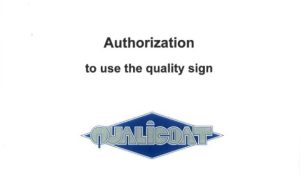Qualicoat-Test Methods and Requirements

Qualicoat-Test Methods and Requirements
The Qualicoat-Test methods described below are used to test finished products and/or coating systems for approval (see chapters 4 and 5).
For the mechanical tests (sections 2.6, 2.7 and 2.8), the test panels must be made of the alloy AA 5005-H24 or -H14 (AlMg 1 – semihard) with a thickness of 0.8 or 1 mm, unless otherwise approved by the Technical Committee.
Tests using chemicals and corrosion tests should be performed on extruded sections made of AA 6060 or AA 6063.
1. Appearance
The appearance will be evaluated on the significant surface.
The significant surface must be defined by the customer and is the part of the total surface which is essential to the appearance and serviceability of the item. Edges, deep recesses and secondary surfaces are not included in the significant surface.The coating on the significant surface must not have any scratches through to the base metal. When the coating on the significant surface is viewed at an oblique angle of about 60° to the upper surface, none of the defects listed below must be visible from a distance of 3 metres: excessive roughness, runs, blisters, inclusions, craters, dull spots, pinholes, pits, scratches or any other unacceptable flaws.
The coating must be of even colour and gloss with good coverage. When viewed on site, these criteria must be fulfilled as follows:
- – for parts used outside: viewed at a distance of 5 m
- – for parts used inside: viewed at a distance of 3 m
2. Gloss
ISO 2813 – using incident light at 60° to the normal.
Note: if the significant surface is too small or unsuitable for the gloss to be measured with the glossmeter, the gloss should be compared visually with the reference sample (from the same viewing angle).
REQUIREMENTS:
- Category 1 : 0 – 30 +/- 5 units
- Category 2 : 31 – 70 +/- 7 units
- Category 3 : 71 – 100 +/- 10 units
(permissible variation from the nominal value specified by the coating supplier)
3. Coating thickness
EN ISO 2360
The thickness of the coating on each part to be tested must be measured on the significant surface at not less than five measuring areas (appr.1 cm2) with 3 to 5 separate readings taken at each area. The average of the separate readings taken at one measuring area gives a measurement value to be recorded in the inspection reports. None of the values measured may be less than 80% of the specified minimum value otherwise the thickness test as a whole will be considered unsatisfactory.
Qualicoat-Test Methods and Requirements
Powders:
- Class 11 : 60 μm
- Class 2 : 60 μm
- Class 3 : 50 μm
- Two-coat powder system (classes 1 et 2) : 110 μm
- Two-coat PVDF powder system : 80 μm
Liquid coating
- Two-coat PVDF system : 35 μm
- Three-coat metallized PVDF system : 45 μm
- Silicon polyester without primer : 30 μm (minimum 20% silicon resin)
- Water-thinnable paints : 30 μm
- Other thermosetting paints : 50 μm
- Two-component paints : 50 μm
- Electrophoretic coating : 25 μm
Other coating systems may require different coating thicknesses, but they may only be applied with the approval of the Executive Committee.
Qualicoat-Test Methods and Requirements
The results must be assessed as shown by four typical examples (minimum coating thickness for coatings of 60 μm):
Example 1:
Measured values in μm : 82, 68, 75, 93, 86 average: 81
Rating: This sample is perfectly satisfactory.
Example 2:
Measured values in μm : 75, 68, 63, 66, 56 average: 66
Rating: This sample is good because the average coating thickness is more than 60 μm and because no value measured is less than 48 μm (80% of 60 μm).
Example 3:
Measured values in μm : 57, 60, 59, 62, 53 average: 58
Rating: This sample is unsatisfactory and comes under the heading “rejected samples” in table 5.1.4.
Example 4:
Measured values in μm : 85, 67, 71, 64, 44 average: 66
Rating:
This sample is unsatisfactory although the average coating thickness is more than 60 μm. The inspection must be considered failed because the measured value of 44 μm is below the tolerance limit of 80% (48 μm).
4. Adhesion
EN ISO 2409
The adhesive tape must be conform to the standard. The spacing of the cuts must be 1 mm for coating thicknesses of up to 60 μm, 2 mm for thicknesses between 60 μm and 120 μm, and 3 mm for thicker coatings.
REQUIREMENTS: The result must be 0.
5. Indentation
EN ISO 2815
REQUIREMENTS:
Minimum 80 with the specified required coating thickness.
6. Cupping test
All powder systems except class 2 and 3 powders2: EN ISO 1520
Class 2 and 3 powders:
EN ISO 1520 followed by a tape pull adhesion test as specified below:
Apply an adhesive tape (see section 2.4) to the coated side of the test panel following the mechanical deformation. Cover the area by pressing down firmly against the coating to eliminate voids or air pockets. Pull the tape off sharply at right angles to the plane of the panel after 1 minute.
REQUIREMENTS:
- – Minimum 5 mm for powder coatings (classes 1, 2 and 3)
- – Minimum 5 mm for liquid coatings except – two-component paints and lacquers : minimum 3 mm – water-thinnable paints and lacquers : minimum 3 mm
- – Minimum 5 mm for electrophoretic coatings
To be indicative, the test must be performed on a coating with a thickness approximating the minimum required.
Viewed with the naked eye, the coating must not show any sign of cracking or detachment, except for class 2 and 3 powders.
Class 2 and 3 powders:
Viewed with the naked eye, the coating must not show any sign of detachment following the tape pull adhesion test
Qualicoat-Test Methods and Requirements

Comments are Closed